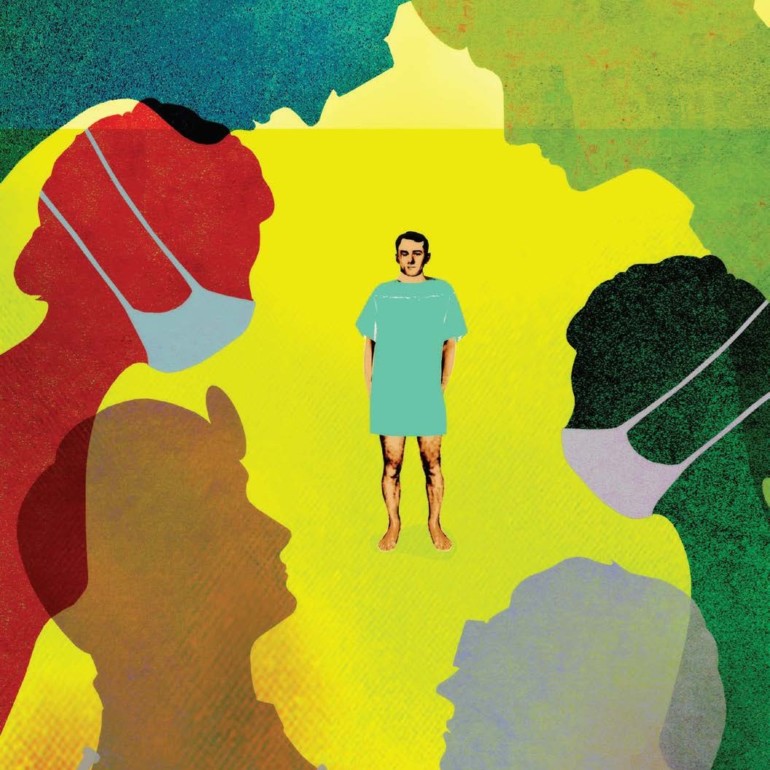FOR TWO YEARS, Corte Madera resident Kirsten Stein suffered from symptoms no doctor could explain. After becoming violently ill over Labor Day 2010 with what seemed like the flu, Stein experienced Bell’s palsy (causing half her face to droop); tingling in her hands, feet and head; and short-term memory issues. For several months, her grip was so impaired she had a hard time holding a pencil.
Before the “flu,” Stein had been a typical active Marin resident. She did CrossFit two to three times a week. She regularly ran and mountain-biked on Mount Tamalpais. But after getting sick, she had to give up working, exercise and volunteering at her children’s school.
Her doctors ordered an MRI, allergy tests and blood work. Nothing showed up in the results. One doctor told her she was stressed out. Another said she was allergic to spinach. Stein, 49, grew so frustrated that at one point, she created an alphabetical list of medical specialties — starting with A for allergist and C for cardiologist — and decided to visit a doctor in every field until someone could tell her what was wrong. It was only when she took her daughter to see a new pediatrician in San Francisco, Dr. Michael Cantwell, that she finally got a diagnosis. He turned to her and said, “You don’t look so good.” After she described her symptoms, he ordered a Lyme disease test for her.
By then, Stein had been sick for more than two years and seen 14 doctors. When the test came back positive for Borrelia burgdorferi, the bacteria that causes Lyme disease, she was elated. Even better, she had tested positive for the one narrow strain of Borrelia that the Centers for Disease Control consider valid for Lyme. “I thought, not only do I have it, but my blood shows I have it, and I’m not crazy,” says Stein.
Stein’s experience goes to the root of what makes Lyme so challenging: it’s a complex and controversial disease, and one that California doctors aren’t always looking for when patients arrive with strange symptoms. It’s also nearly impossible to tell how many cases of it we have in Marin.
According to Marin County’s Department of Health and Human Services, there were no confirmed cases of Lyme in Marin in 2017 and only two cases in 2016. This makes Marin a “low-incidence” county. And yet when I asked around among my friends, trying to find Lyme sufferers for this story, at least 10 people came forward within 24 hours to speak about their experiences.
Raphael Stricker, M.D., past president of the International Lyme and Associated Diseases Society — and a San Francisco internist with more than 4,000 Lyme patients in his practice — points to a similar pattern throughout California. “There’s a huge disconnect there,” he says. “There are a lot of cases that aren’t being counted by the health department.”
According to the CDC, there were 90 reported cases of Lyme in California in 2016. But a study co-authored by Stricker in the International Journal of General Medicine shows that in that same year, there were 46,000 insurance claims related to Lyme disease in the state.
So which is it? Do we have zero Lyme in Marin? Or are there a fair number of cases here, and throughout California, as anecdotal evidence suggests? “Both are true, unfortunately,” says Matt Willis, M.D., the county’s public health officer. “Your friends are not lying. But they have been probably been diagnosed by methods that do not count as an official case in the eyes of the California Department of Public Health or the CDC.
The honest response is that there’s a lot we’re learning about Lyme disease,” adds Willis, who suffered from the disease himself in 2000, while at medical school in Boston. (He found out quickly and treated it with antibiotics.)
Lyme is statistically one of the fastest-growing infectious diseases among the populace in the United States, and the CDC estimates that around 300,000 Americans suffer from it each year. There were a record number of tick-borne diseases reported in the country in 2017, including Lyme, babesiosis and Rocky Mountain spotted fever. And a number of experts are concerned that as the planet grows warmer, tick populations may increase too.
In California, the tick that carries Lyme is the western black-legged tick, which lives on host creatures like deer, rodents, and small animals such as gray squirrels. Ticks feed on blood, and because they cannot jump or fly, they wait at the ends of grass or foliage, latching on to clothing or skin as humans and other creatures pass by. In order to transmit diseases, ticks typically need to be attached to the skin for 36 to 48 hours.
Fortunately, Marin’s ticks have a low infection rate. According to Kelly Liebman, scientific programs manager at the Marin/Sonoma Mosquito and Vector Control District, about 2 percent of adult ticks and 4 percent of nymphs — young ticks, which can be as small as poppy seeds — are infected with Lyme. Adult ticks are most active from the first fall rains into the spring, and nymphs are most active in the spring into the summer months.
Unfortunately, it can be difficult to tell if you’ve been infected. The CDC estimates that only 70 percent of people with Lyme develop the telltale “bull’s-eye” rash, and even that can vary by geographic region. The two-tiered blood test for Lyme, the ELISA and Western blot test, misses up to 60 percent of acute Lyme cases, yet it’s the only form of testing the CDC considers valid. “The testing is antiquated and not very accurate, unfortunately,” Stricker says.
This may change. A company in Palo Alto, IGeneX Laboratories, has developed much more sensitive testing for Lyme and is now trying to get FDA approval. Efforts to create a Lyme vaccine are also underway.
But for now, Lyme remains difficult to diagnose — and can be just as tough to treat. If it’s detected within the first 30 days after a tick bite, a simple course of antibiotics usually cures the infection. But for people who go undiagnosed for months or years, it can be much more challenging, resulting in “late-stage” or “post-treatment Lyme disease.”
That was the case for Lucas Valley resident Lia Gaertner, 46, who was infected twice in a 10-year period — once on the East Coast, while earning a graduate degree in ethnobotany at Cornell, and again in Mendocino, where the incidence rate is higher than in Marin because it’s wetter there and farther north. Gaertner suffered baffling symptoms such as rapid heartbeat and heart palpitations, anemia, and night sweats. “I had 10 years of not being able to sleep at night because of the intense heart palpitations,” she says.
Like Stein, Gaertner visited countless doctors. It was only in 2008 — 10 years after her first infection — that a colleague of her husband (who is a doctor) correctly diagnosed her. Gaertner tested positive for Lyme, and other tests indicated that she also had the tick-borne disease Babesia. Co-infections are common in Lyme sufferers and were a problem for Stein, too.
Gaertner, who’s now on the Bay Area Lyme Foundation’s advisory board, underwent a grueling course of treatment, which included at least six months of antibiotics and fistfuls of natural remedies. Sometimes she swallowed as many as 80 pills, supplements, herbs and tinctures a day. It worked. Five years after her diagnosis, in 2013, she competed in the Tough Mudder race in Tahoe. A year later she ran a half-marathon.
As Gaertner and Stein’s stories illustrate, Lyme can be devastating if not intercepted early. But there’s also good news: Matt Willis says a number of events have to occur for someone to become infected in Marin. You need to be bitten specifically by a western black-legged tick (not just any tick). It has to be one of the 2 to 4 percent of ticks that is infected. And it has to embed in your skin for at least 24 hours. “If I have one lingering concern around this, it’s that people have an exaggerated sense of the risk and that it may prevent them from engaging in the healthiest behavior, which is getting physical activity outdoors,” Willis says. “But it’s all about exposure. And there are things we can do to prevent being bitten by a tick.”
Best Prevention Measures
- When heading outdoors, apply an EPA-registered insect repellent to your skin, such as DEET, picaridin or oil of lemon eucalyptus (the latter two are DEET-free alternatives).
- Treat boots, clothing and camping gear with products containing 0.5 percent permethrin, which repels ticks.
- Wear light-colored clothing (to make it easier to spot ticks) when outdoors, as well as long pants, long sleeves and long socks.
- Stay on trails, and avoid contact with nymph habitat such as leaf litter, logs, blades of grass and tree trunks.
- Shower soon after being outdoors. According to the CDC, showering within two hours of coming indoors has been shown to reduce the risk of Lyme disease.
- Check your body and clothing for ticks upon returning from potentially tick-infested areas, including your own backyard. Use a hand-held or full-length mirror to view all parts of your body.
- Run clothing through a dryer on high heat for at least 10 minutes to kill any ticks after you come indoors.
- If you are bitten by a tick, says Dr. Willis, use fine-nosed tweezers to reach in and try to grab the embedded tick head. Apply steady, gentle traction backwards to remove it.
- Dogs can get tick-borne diseases too, so be sure to put flea-and-tick repellent on them. When walking dogs, keep them on leash so they don’t stray into tick-rich environments, and do a tick check when you’re finished.


